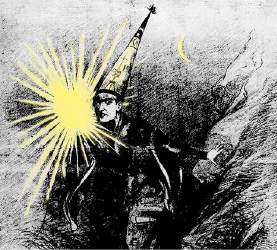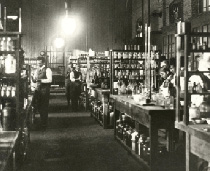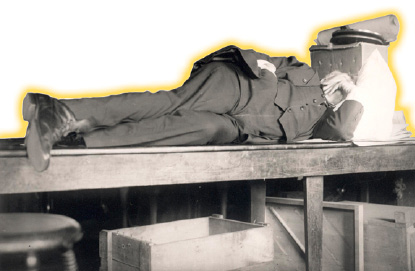Chapter Four
The Idea Business

This 1879 newspaper cartoon of Edison is titled “The Wizard’s Search.”
How did Edison accomplish such a lifetime of impressive inventions and achievements? Much of it was possible because Edison established an “idea factory” where he and his assistants could carry out the necessary research and experiments needed to explore Edison’s many ideas.
In 1876, Edison began looking for a place where he could settle his family in a larger home and also build a laboratory. He discovered two tracts of land in a farming village called Menlo Park, New Jersey. A secluded, rural site, located about 25 miles southwest of New York City, it was the perfect setting for a laboratory. Not yet 30 years old, Thomas Alva Edison was ready to embark on what might be considered his greatest invention—an idea factory that would set the standard for industrial research and development for years to come.
By the spring of 1876, a simple, two-story structure had been erected at Menlo Park. The ground floor housed Edison’s office, with a library in the front and a machine shop in the back. His laboratory was located on the second floor. There, the walls were lined with shelves that held about 2,500 bottles of chemicals.
Edison worked at his Menlo Park lab for about 10 years. It was the site of the birth of the phonograph and his electric light system. Edison caught the world’s attention with his phonograph and became famous while working at this site. He was dubbed “the Wizard of Menlo Park.”
In 1887, Edison established a newer and larger laboratory site in West Orange, New Jersey, less than a mile from Glenmont, his home. Five structures—a main, three-story laboratory and four other buildings for specialized purposes—were raised there so that everything required for testing in chemistry, electricity, and physics was available. The site’s size allowed for as many as 20 experiments to be worked on simultaneously.
Edison’s laboratory used team-based research. The men who worked for him were called “muckers.” Often, they were young and stayed with Edison for only a few years. Edison was a tough boss: It was his lab, and his ideas prevailed, but it was considered a privilege to work for the famous inventor.

The shelves of the West Orange laboratory were stocked with anything that one of Edison’s muckers might possibly have needed.
“An experimenter never knows five minutes ahead what he does want,” Edison thought, so he filled his lab with a large assortment of chemicals, as well as every kind of metal in existence. He also kept a supply of odd materials with which his workers could experiment, or “muck around,” such as hog bristles, walrus hides, porcupine quills, peacock tails, and bull horns. Edison claimed his lab had everything a mucker could possibly need “from the hide of an elephant to the eyeballs of a United States Senator.”
A constant presence at the lab, Edison earned the nickname “the Old Man.” He had interesting work habits. He had an aversion to watches because he did not want to know the time, and he believed in working six days a week, 10 hours a day. Edison often worked through the night. He had developed this habit as a young man, when he chose to work nights and leave his days free for inventing.

Edison takes a catnap on a laboratory table.
At Menlo Park, Edison had a cabinet built beneath the stairwell where he could sleep. At West Orange, he kept a cot in his office. But Edison often could be found napping while sitting in a chair or lying on top of or beneath the nearest table.
During its most productive years (1914–1918), Edison’s West Orange site employed more than 200 people. Over time, a number of factories were added to the complex, which eventually employed up to 10,000.
“Genius is one percent inspiration, 99 percent perspiration,” Edison once said. He believed that it took hard work to turn his inventions into reality. And Edison did not sit back once inventions were completed—he constantly strove to improve them. He continued to work on the phonograph, light bulb, and even the telephone (which had been invented by Alexander Graham Bell in 1876), saying, “There’s a better way to do it. Find it.”
Edison was 40 years old when the West Orange lab was opened, and he worked there until his death at age 84 in 1931. More than half of Edison’s 1,093 patents came out of this famous laboratory.